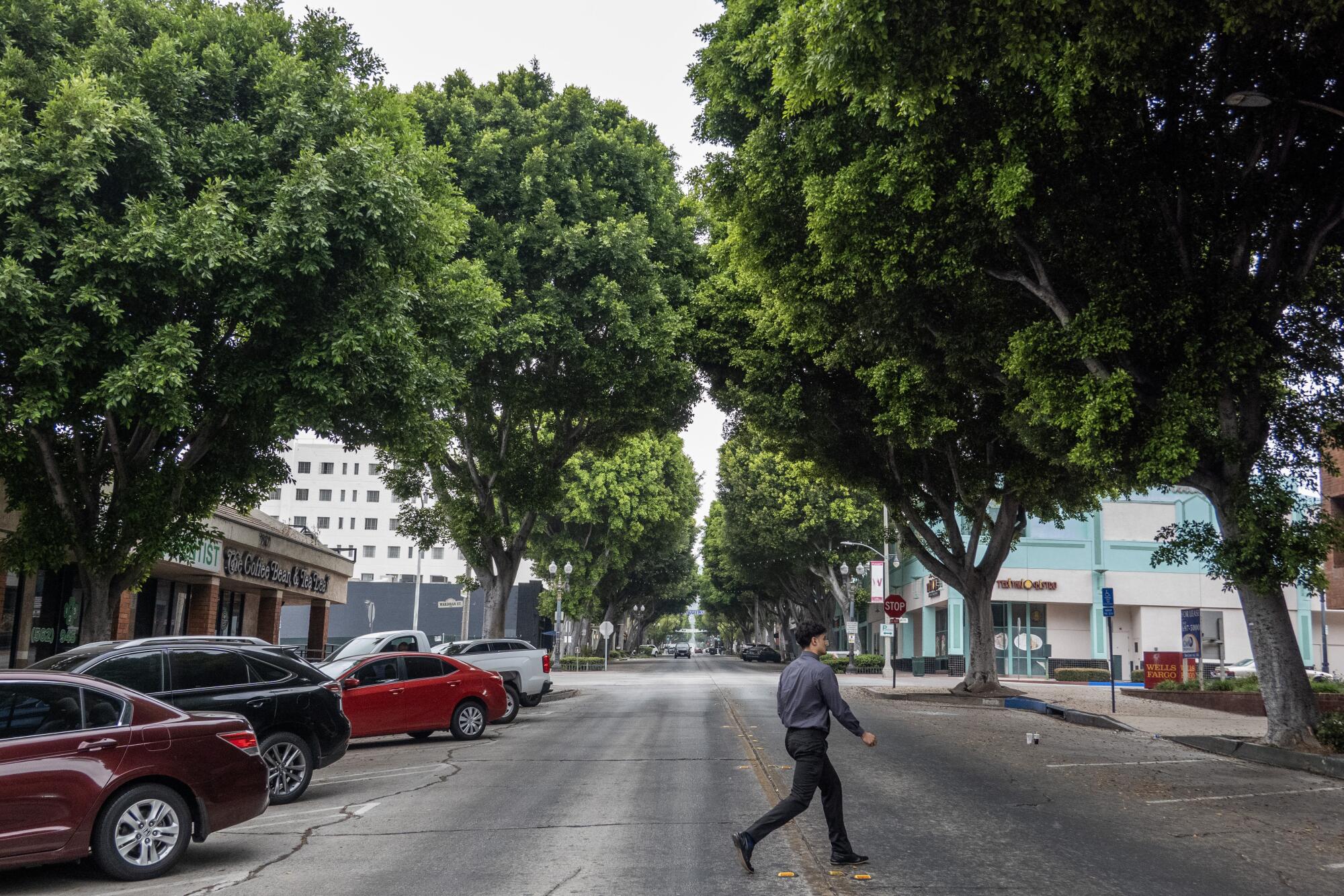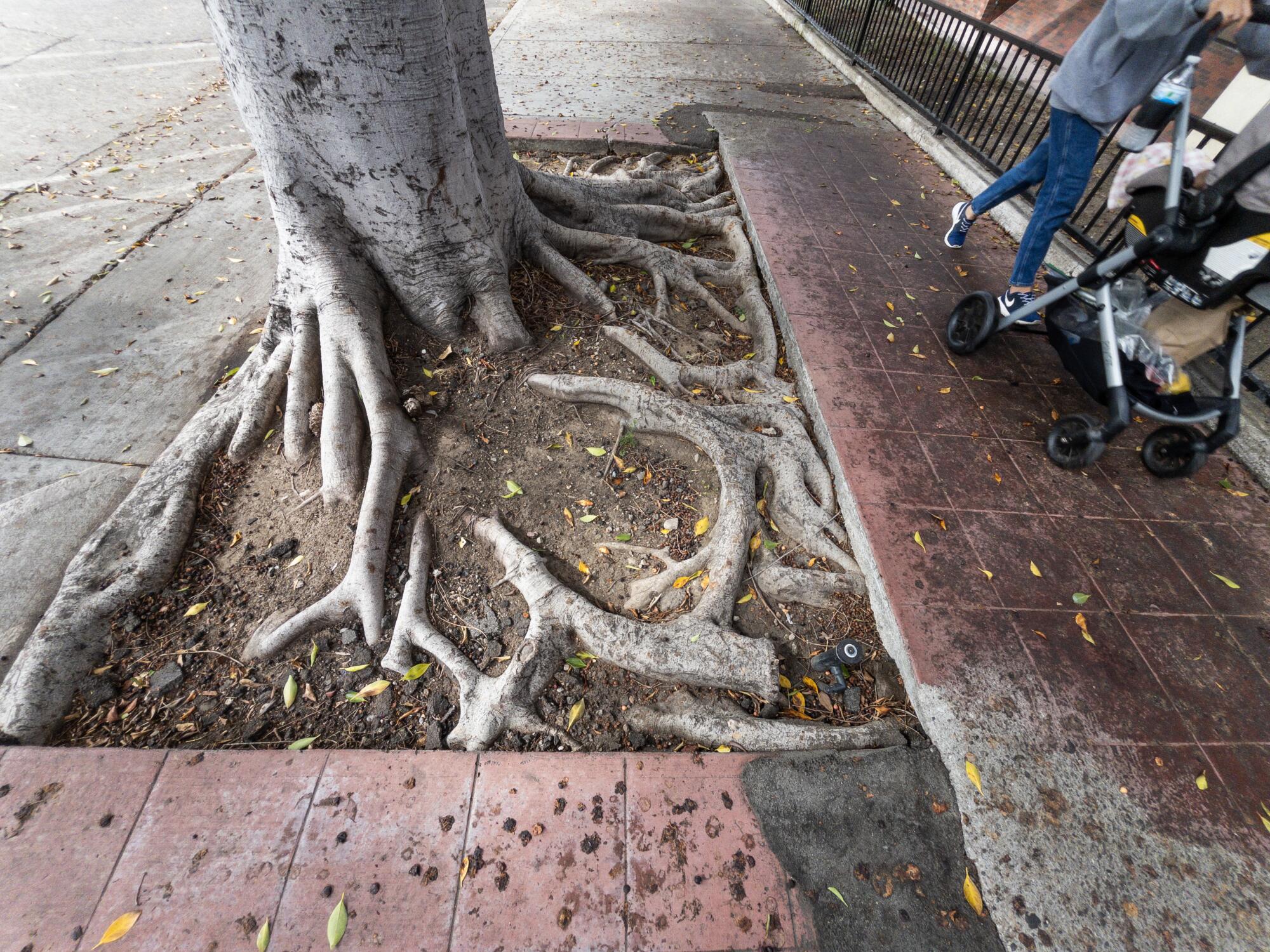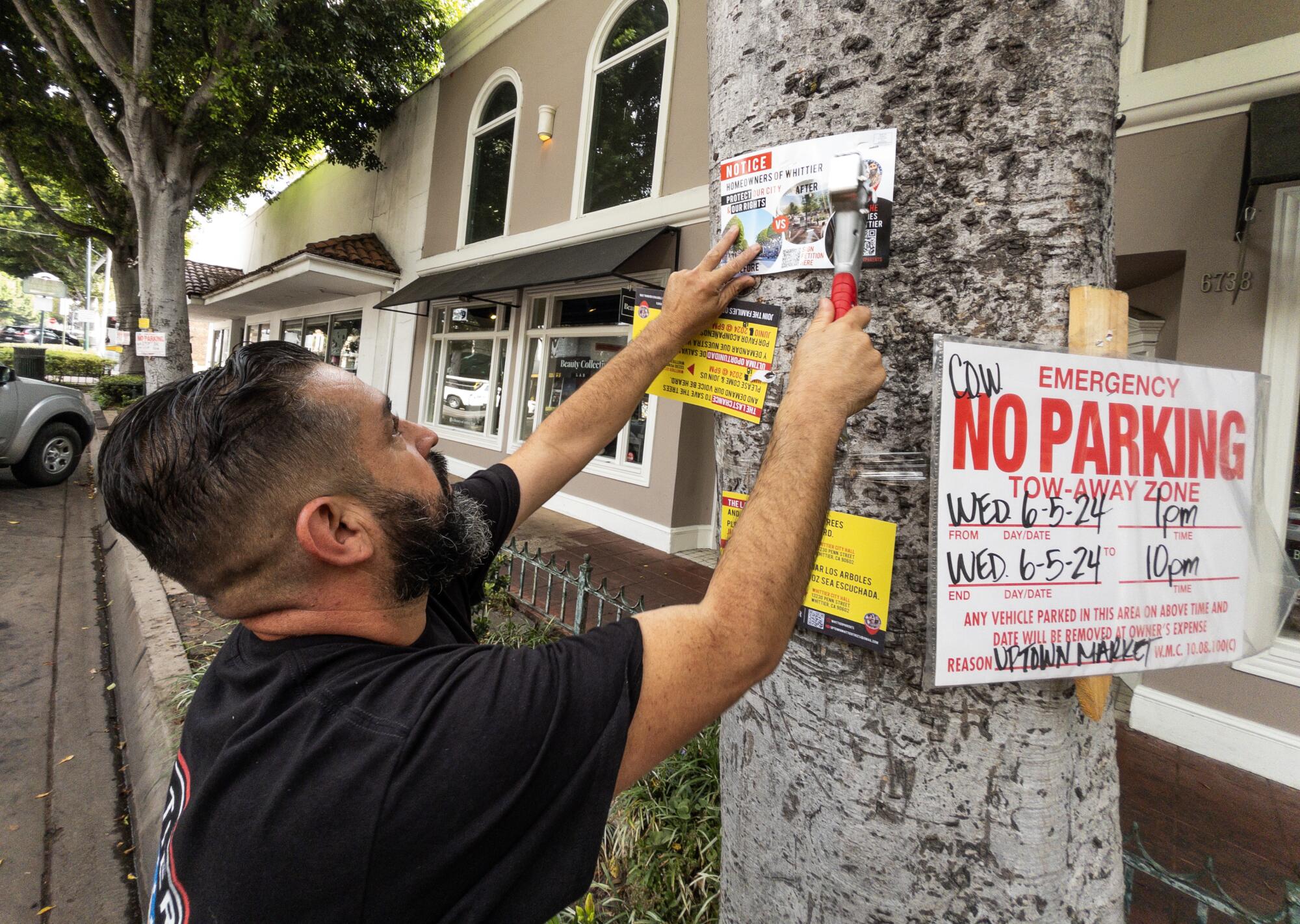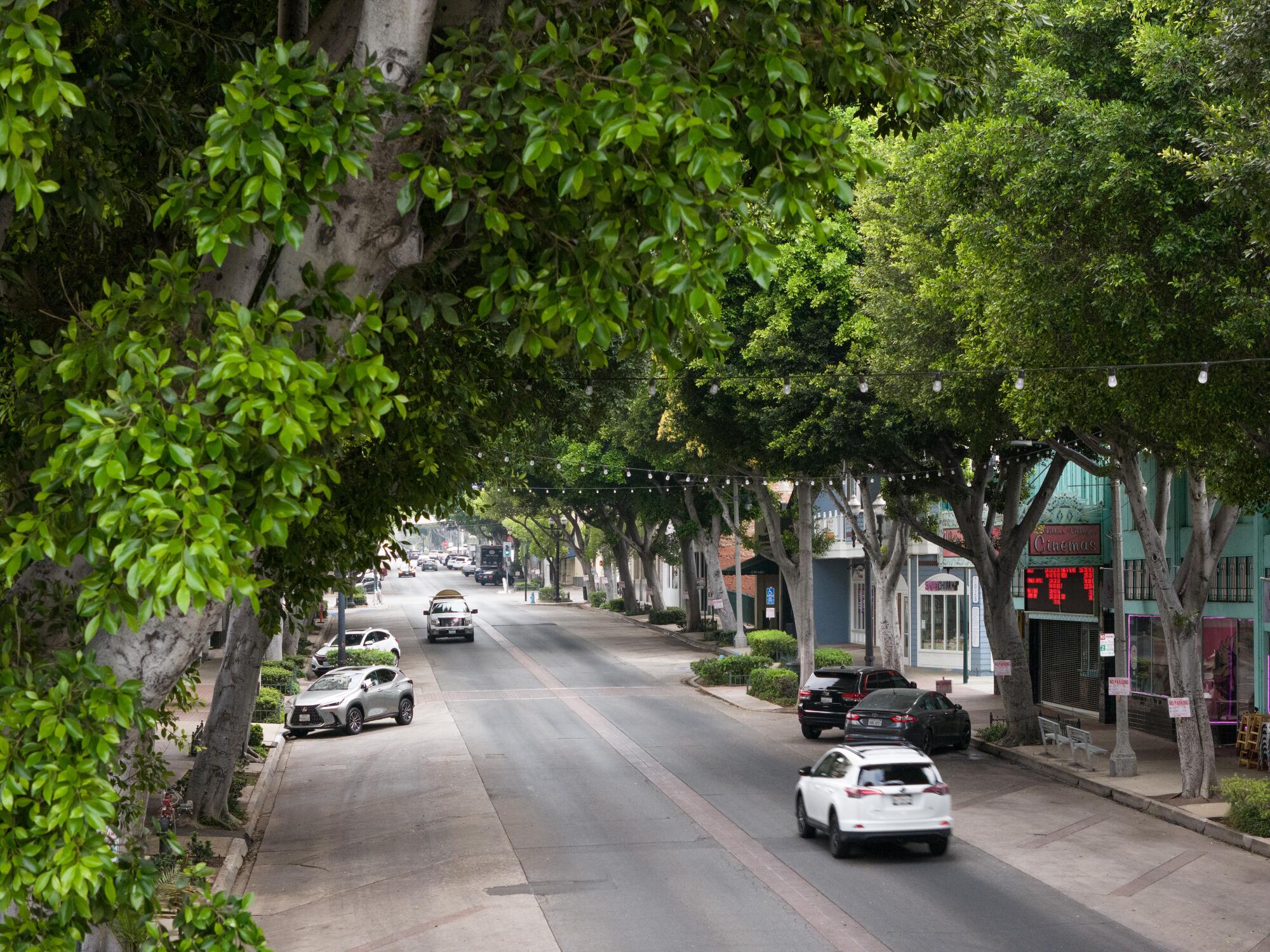Whittier will move forward with the removal of 83 ficus trees as part of a commercial center redesign despite opposition to the plan.
On Tuesday night, City Council members voted 3 to 1 to proceed with a $20 million redevelopment project in Uptown Whittier that would require the removal of all ficus trees in the three-block project area.
The decision follows months of public outcry over the fate of the trees following the mid-December approval of the Greenleaf Promenade.
The project is said to be a means of making the area more pedestrian-friendly and providing financial life to the area, but some residents believe sacrificing tall trees – with their cool canopies and majestic appearance – is not a fair trade-off.
City leaders say they finally see promise in the refresh, while pointing to health and safety concerns posed by the trees.
“I’m looking forward to revitalize Uptown with new trees, new architecture, new light, new sidewalks – that I can all be proud of,” said Councilor Fernando Dutra before voting in support of the project.
Mary Ann Pacheco, a new addition to the council, cast the lone opposition. He said the plan suffered from poor optics, which could be remedied by overhauling the planning process.
“The understanding in the city is completely wrong, and it has been done for the wrong reasons,” she said. “I’m not going to say that, but until the real problem is dealt with, the trees will continue to be – quote – the problem.”
The debate over the trees has divided the community, pitting some business owners against residents — and against each other. There have even been calls to boycott businesses that seem to be considering their removal.
Some see the trees as synonymous with the character of the quiet community located in the eastern part of Los Angeles County, and praise for providing shade and gobbling greenhouse gases in a warm world.
Others blame non-native trees for lifting sidewalks and clogged sewers with roots, or willing to sacrifice trees to break ground in a project they believe will bring economic vitality.
More than 40 speakers passionately shared their perspectives during public comments at the meeting, with almost all opposing the removal of the trees.
Helen Rahder, executive director of the Whittier Conservancy, called the plan “absurd” during public comments.
“It’s in your hands, and you have the ability to do it: revise the plan to include trees,” he said. “You have to go back to the drawing board on this. The public will not accept this.

Greenleaf Avenue in Whittier on June 5, 2024. Some blame the trees for sidewalk and pipe problems, while others like the shade.
(Myung J. Chun / Los Angeles Times)
Tensions rose several times during the meeting, which lasted about four hours. Audience members frequently insulted officials and twice Mayor Pro Temp Cathy Warner ordered a break in the middle of the commotion.
Someone called out when the meeting was adjourned, “You’re not fun!”
Several councilors expressed their disappointment in the discourteous tone of the debate — in and out of City Hall — during the comments.
At the meeting, council members approved modifications to the project, including replacing the trees slated for removal with larger trees than previously envisioned, as well as adding an umbrella structure to cover the sidewalk. The changes appear to be in response to concerns about possible loss of canopy and shade, and possible increased carbon sequestration.
According to consultants hired by the city, there will be a significant decrease in carbon sequestration in the first year after the current canopy is replaced, at a rate predicted to break down in 24 years based on initial plans.
“The break-even year will come sooner in this scenario with larger trees,” said Alan Ashimine of Michael Baker International, which provides environmental consulting. “Bigger trees planted will mature faster and absorb carbon earlier in life.”
City officials also explore options to phase in the project over time and answer more than 50 questions posed in public comments, including the legal responsibility posed by tree hazards, environmental documentation and historical streetlights.
“We will not give up!” resident Conny McCormack said in a text message the day after the meeting. McCormack, who has been among those leading the opposition to tree removal, suggested a lawsuit might be in order.
Ever since residents learned of the plan to uproot the trees, they have been massing in meetings, holding rallies and circulating petitions to protest the removal of the trees at once to make way for the Greenleaf Promenade.

Ficus roots can lift sidewalks and clog sewers, prompting some residents to support their removal in Uptown Whittier.
(Myung J. Chun / Los Angeles Times)
City leaders are paying attention. A new “study session” focused on trees was resumed after the protest.
According to city officials, construction elements, such as the required grading, cannot save ficus trees.
At the meeting, City Manager Brian Saeki said the city can’t remove all the other trees because of tree protection zones, or areas around trees where “no construction can happen … without jeopardizing the health of the tree.”
Some other types of trees along the road may be saved, officials said.
One point of broad agreement is that Uptown Whittier, considered the heart of the city, could use a little love. The last update was in the 1980s, including renovations after the 1987 Whittier Narrows earthquake that devastated the area.
The envisioned promenade stretches from Wardman Street to Hadley Street, along Greenleaf Avenue, and includes more sidewalks, outdoor dining, gathering spaces, street furniture and decorative lighting.
City officials are “committed to revitalizing Uptown Whittier into a thriving, walkable and pedestrian-friendly area for generations of residents to enjoy,” Saeki said in a statement last month. To realize his “long-held vision,” he said, it was necessary to remove certain trees in the project area.
“We understand the community’s concerns, we appreciate the feedback we’ve received,” Saeki said, adding that the city will plant larger replacement trees “wherever possible,” as well as add 39,000 square feet of landscaping and 18,000 square feet of new parkland. premises.
A similar but smaller pilot project was approved in 2019 but was shelved by the pandemic, according to city officials. At an estimated cost of $3.8 million, the one-block Gardens of Uptown is different in a way that some see as important: It preserves a cluster of ficus trees.
Over the next few years, city officials say, the project evolved and evolved, partly in response to changing preferences born of the pandemic. Greenleaf Promenade costs about five times that of the pilot project.

Last month, Javier Garcia posted a notice asking homeowners to protect the ficus trees on Greenleaf Avenue.
(Myung J. Chun / Los Angeles Times)
Through it all, Uptown Whittier retains its small-town atmosphere. Greenleaf Avenue is lined with mom and pop shops, such as the more than 70-year-old Lovell’s Records, interspersed with newer establishments, such as La Sexy Michelada, bars and restaurants.
Today, the ficus trees that caused controversy – believed until the late 1960s – create a shady canopy on the road. Some of its advantages and disadvantages are clearly presented. Step out the branches that come out on a warm day and prepare to be sunk by the sun. But walk down the sidewalk when they’re dropping berries, and expect organic muck.

The trees that have caused controversy in Uptown Whittier are believed to date back to the late 1960s. Some see them as the center of the city’s look and feel.
(Myung J. Chun / Los Angeles Times)
Whittier isn’t the only one struggling with ficus ambivalence.
Beverly Hills cleared more than 50 ficus trees as part of a sidewalk renovation project before a judge ordered the city to stop it through a preliminary injunction. Following that decision, the city opted to complete an environmental impact report for the project, which is still in progress.
In 2018, Pasadena city officials held a meeting to gather public input on whether to keep planting ficus trees, as well as how they would affect Green Street. In March of last year, a group of Pasadena Beautiful Foundation volunteers reported planting 30 ficus trees along the street.




